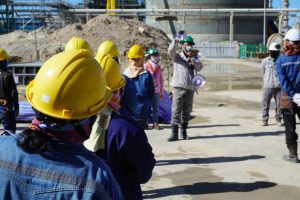In any environment where safety and well-being are accounted for, effective visitor management plays a crucial role. This is particularly true in settings such as construction sites, clinics, manufacturing facilities, and a range of workplaces in which controlling access and ensuring a safe environment are top priorities. In this article, we’ll explore the significance of visitor management systems, their key components, and how they contribute to overall health and safety protocols.
Understanding visitor management systems
Visitor management systems encompass a range of tools and procedures designed to monitor and control access to a facility. These systems serve multiple purposes, including enhancing security, tracking visitor movements, and ensuring compliance with health and safety regulations. In today’s increasingly regulated environments, implementing robust visitor management systems is not just a choice but often a legal requirement.
Key components of visitor management systems
Check-in procedures: The process begins with visitors checking in upon arrival. This can involve electronic kiosks, reception desks, or mobile apps where visitors provide identification, purpose of visit, and other relevant information. This initial step sets the foundation for monitoring who enters the premises.
Identification and badges: Once checked in, visitors are typically issued identification badges. These badges often include their name, photo, and any specific permissions or restrictions. The visibility of badges helps personnel easily identify authorized individuals and ensures visitors are in appropriate areas.
Monitoring and tracking: Modern systems utilize technology to monitor visitor movements throughout a facility. This allows real-time tracking and helps ensure visitors are only accessing approved areas.
Integration with security systems: Effective visitor management systems integrate with existing security infrastructure. This includes access control systems, CCTV cameras, and alarms. Integration enhances overall security by providing a comprehensive view of who is on-site and their activities.
Compliance and reporting: Comprehensive systems often include features for generating reports and ensuring compliance with regulatory requirements. This capability is crucial for audits and demonstrating adherence to health and safety standards.
Benefits of effective visitor management
Implementing a robust visitor management system offers several benefits that directly contribute to health and safety:
Improved security: By accurately identifying and tracking visitors, organizations can mitigate risks associated with unauthorized access.
Emergency preparedness: In the event of emergencies, knowing who is in the facility and where they are located is critical for evacuation procedures and ensuring everyone’s safety.
Regulatory compliance: Many industries have strict regulations governing visitor access and safety. A compliant visitor management system helps organizations meet these requirements effortlessly.
Enhanced efficiency: Streamlined check-in processes reduce wait times and administrative burdens on staff, allowing them to focus on core responsibilities.
Visitor experience: A well-managed check-in process contributes to a positive visitor experience, reflecting positively on the organization’s reputation and professionalism.
Applications in health and safety
In work settings such as a manufacturing facility, visitor management is especially critical due to the vulnerability of internal employees, equipment, and other assets. Workplaces must balance health and safety protocol with the need to allow appropriate access for visitors such as contractors. Here’s how effective visitor management contributes to health and safety in manufacturing:
- Incident control: Strict visitor policies help prevent the increased likelihood of incidents associated with unauthorized access.
- Internal safety: Screening visitors ensures employees are not exposed to individuals who may pose a risk to their health and safety.
- Regulatory compliance: Manufacturing facilities must adhere to regulations such as OSHA’s visitor management guidelines.
- Emergency response: During emergencies or natural disasters, knowing the whereabouts of visitors is crucial for managing evacuations and ensuring everyone’s safety.
Challenges and considerations
While visitor management systems offer numerous benefits, their implementation can present challenges:
- User training: Staff and visitors may require training to understand how to use the system effectively, particularly if it involves new technology.
- Integration complexity: Integrating with existing infrastructure, such as access control systems, contractor management software and risk auditing tools can be complex and may require specialized expertise.
- Visitor experience: Balancing security with a positive visitor experience is essential. Long wait times or cumbersome check-in processes can frustrate visitors.
- Cost considerations: Implementing a robust system may involve upfront costs for technology, installation, and ongoing maintenance.
Future trends
Looking ahead, visitor management systems are likely to evolve with advancements in technology. Artificial intelligence (AI) and machine learning could enhance system capabilities, such as predictive analytics for visitor behavior or facial recognition for streamlined check-ins. Additionally, mobile-friendly solutions are becoming increasingly popular, allowing visitors to check in using their smartphones.
Closing remarks
In conclusion, effective visitor management is not just about controlling access; it’s about safeguarding health, ensuring safety, and maintaining regulatory compliance. Whether in construction, manufacturing, or healthcare settings, investing in a robust visitor management system is an investment in the well-being of everyone within the facility. By leveraging technology and best practices, organizations can create secure environments that protect both visitors and staff, ultimately contributing to a safer and more efficient workplace.
Addison Moore is Director of Marketing at Contractor Compliance.

